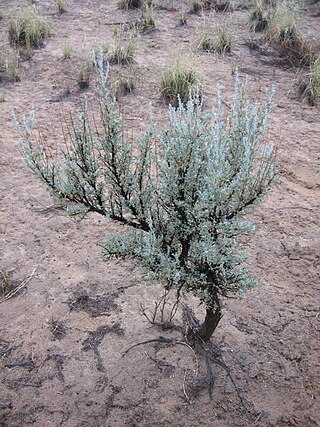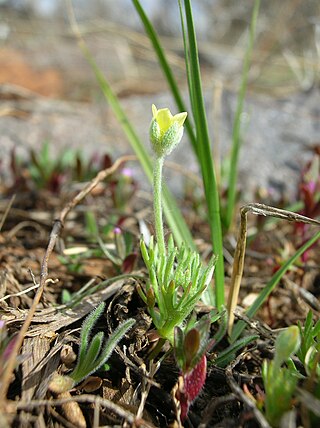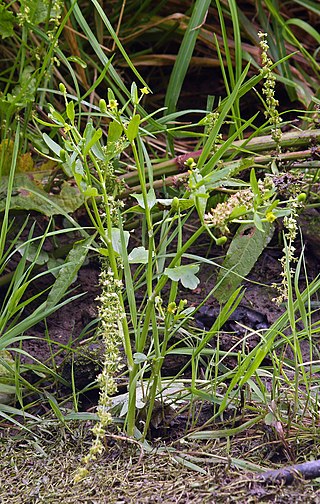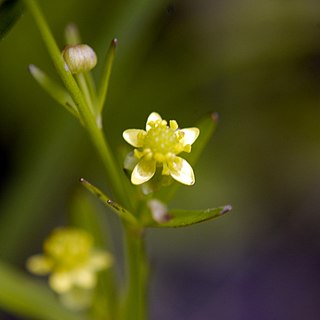
Ranunculus is a large genus of about 1700 to more than 1800 species of flowering plants in the family Ranunculaceae. Members of the genus are known as buttercups, spearworts and water crowfoots.

Artemisia tridentata, commonly called big sagebrush, Great Basin sagebrush or simply sagebrush, is an aromatic shrub from the family Asteraceae.

Ranunculus pygmaeus, the pygmy buttercup or dwarf buttercup, is a species of buttercup found throughout the Arctic, as well as in the mountains of Norway and the Rocky Mountains. A few populations also exist in the Eastern Alps and Tatra Mountains.

Ranunculus bulbosus, commonly known as bulbous buttercup or St. Anthony's turnip, is a perennial flowering plant in the buttercup family Ranunculaceae. It has bright yellow flowers, and deeply divided, three-lobed long-petioled basal leaves.

Purshia tridentata, with the common name bitterbrush, is a shrub in the genus Purshia of the family Rosaceae. It is native to mountainous areas of western North America.

Viola beckwithii, known commonly as the Great Basin violet, Beckwith's violet, and sagebrush pansy, is a species of violet native to the western United States. It is an early-flowering plant of sagebrush habitats in the Great Basin region.

Ceratocephala testiculata is a flowering plant that is native to Eurasia. Common names include bur buttercup and curveseed butterwort. It is very small, usually only about an inch or two tall, but potentially growing to four inches. The flowers are small and dull yellow. The leaves are hairy and somewhat dissected. It produces a cluster of hard, spiny fruits. Like other members of the buttercup family, they are poisonous. Where they are present in large numbers, it is usually an indication of excessive disturbance to the land.

Ranunculus sceleratus known by the common names celery-leaved buttercup, celery-leaf buttercup, and cursed buttercup is a species of flowering plant in the buttercup family Ranunculaceae. It has a circumpolar distribution in the northern hemisphere, native to temperate and boreal North America and Eurasia, where it grows in wet and moist habitats, including ponds and streambanks.

Primula conjugens, synonym Dodecatheon conjugens, is a species of flowering perennial plant in the primrose family, known by the common name Bonneville shooting star.

Arnica sororia is a North American species of flowering plant known by the common name twin arnica. It is native to Western Canada and the Western United States. It grows in grasslands and in conifer forests, as well as the sagebrush steppe.

Ranunculus alismifolius is a species of buttercup known by the common name plantainleaf buttercup. It is native to western North America from British Columbia to California to Colorado, where it grows in moist mountain habitat such as meadows, streambanks, and bogs, becoming common to abundant in some places. It is somewhat variable in appearance and there are several varieties which can be hard to tell apart. In general the plant is a perennial herb producing a few usually upright to erect, branching stems from a fleshy, fibrous root system. It can be up to half a meter tall, or it can remain quite short and clumpy. The leaves vary in shape, the lower ones with oval blades and the upper linear to lance-shaped, all borne on long petioles. The inflorescence bears one or more flowers, each on a long pedicel. The flower has up to 12 yellow petals and many yellow stamens and pistils at the center. The fruit is an achene, borne in a spherical cluster of 12 or more.

Ranunculus andersonii is a species of buttercup known by the common name Anderson's buttercup. It is native to the western United States, including the Great Basin and surrounding regions, where it grows in sagebrush, woodlands, and other habitat. It is a perennial herb producing a basal rosette of thick leaves which are each divided into three double-lobed leaflets at the end of a petiole. The inflorescence arises from the rosette on an erect, leafless stalk usually no more than 20 centimeters tall. It bears one flower with usually five white or red-tinged petals each up to 2 centimeters long with white or pinkish sepals at the base. At the center of the flower are many yellow stamens and pistils. The fruit is an achene, borne in a spherical cluster of 14 or more. It was named after Charles Lewis Anderson by Asa Gray.

Ranunculus eschscholtzii is a species of buttercup flower known by the common name Eschscholtz's buttercup.

Ranunculus pusillus, commonly called low spearwort, is a species of flowering plant in the buttercup family (Ranunculaceae). It is native to much of the eastern United States from New York to Florida and west to Texas; it is also known in California. It grows in wet habitat, where it is semi-aquatic growing partially submerged or terrestrially on muddy substrates.

Stanleya pinnata is a species of flowering plant in the family Brassicaceae known as desert prince's-plume. It is a perennial herb or shrub native to North America.

Thelypodium laciniatum is a species of flowering plant in the mustard family known by the common name cutleaf thelypody. It is native to western North America, particularly the Great Basin and surrounding plateau and foothill habitat, where it grows on dry rocky cliffs and hillsides in sagebrush and scrub, usually below 2,400 metres (8,000 ft) elevation.

Ranunculus auricomus, known as goldilocks buttercup or Greenland buttercup, is a perennial species of buttercup native to Eurasia. It is a calcicole typically found in moist woods and at the margins of woods. It is apomictic, and several hundred agamospecies have been recognised.

Ranunculus abortivus is a species of flowering plant in the buttercup family, Ranunculaceae. Its common names include littleleaf buttercup, small-flower crowfoot, small-flowered buttercup, and kidneyleaf buttercup. It is widespread across much of North America, found in all ten Canadian provinces as well as Yukon and the Northwest Territories, and most of the United States, except Hawaii, Oregon, California, and parts of the Southwest.

Ranunculus fascicularis, commonly called early buttercup, is a species of flowering plant in the buttercup family (Ranunculaceae). It is native to the eastern North America, where it is found in Canada and the United States. It is generally widespread in eastern North America, although its populations become sporadic in areas east of the Appalachian Mountains and south of New England. Its natural habitat is in dry areas with sparse vegetation, such as rocky or sandy bluffs, prairies, and savannas.

Ranunculus allegheniensis is a species of flowering plant in the buttercup family, Ranunculaceae. Its common names include Allegheny Mountain buttercup and Allegheny crowfoot.
























